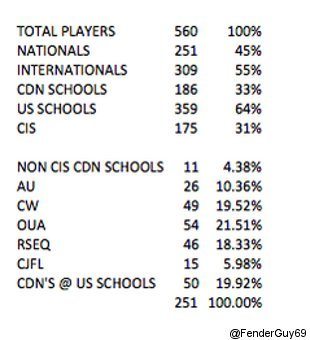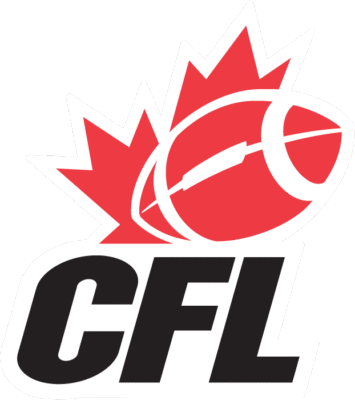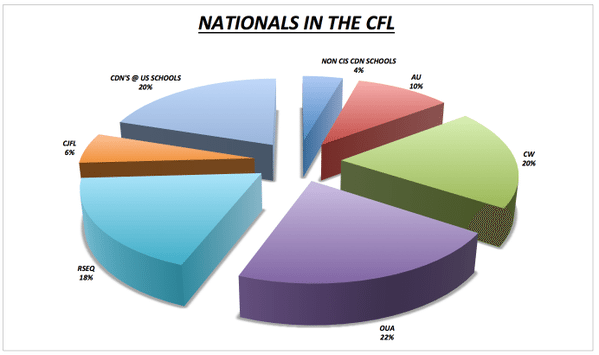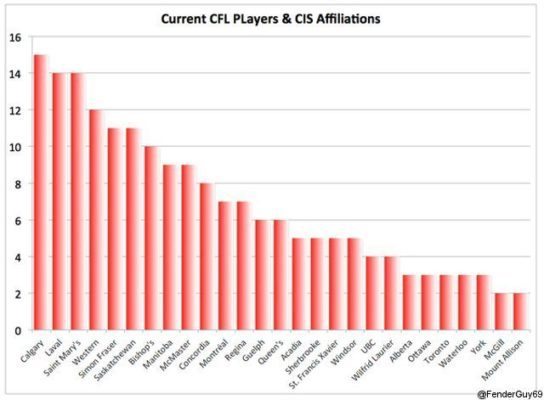You Would Be Surprised Where the Players in the Canadian Football League come from!
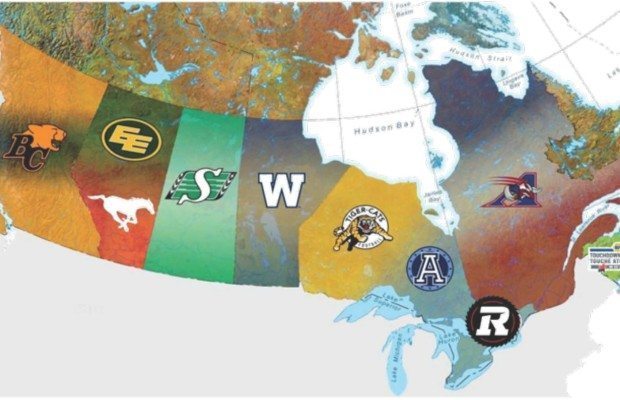
Breaking down the Canadian Football League by nationality, school, division and more
One fascinating facet of the CFL is how it’s comprised of players from remarkably different backgrounds. The CFL has Canadians and Americans, players from all levels of college and junior, and players of all different sizes. Mark Fulton, a prolific Twitter user and a writer for the Hamilton Ticats’ blog Blogskee Wee Wee, has been doing some terrific work on this, pulling together lists of the CFL’s players and where they come from. As you can see in the table at right (based on data as of Jan. 1), he’s broken it down into both nationals (mostly Canadians) and internationals (mostly Americans) and what playing background each of them come from.
Those numbers are interesting enough in their own right. First off, it’s notable that only 45 per cent of the players on CFL rosters are nationals. Second, only 33 per cent of total players are coming from Canadian schools, and only 31 per cent are coming from CIS schools. (The “Non-CIS CDN Schools” category is B.C.’s Simon Fraser University, which competes in NCAA Division II.) Those are still significant numbers for CIS, but they’re lower than what we’ve sometimes seen in the past, which is more evidence of the rising numbers of Canadians finding major success in the NCAA.
It’s notable that CIS still produces the majority of Canadian players, though, with 69.8 per cent of national players coming from the Canadian university ranks. That’s a combination of the percentages we’ve seen in the draft recently; the CIS produced 73.3 per cent of the draftees in 2013, but just 53.3 per cent in 2012. (2014, where 90.8 per cent of the picks were from CIS, can be largely discounted thanks to changing eligibility rules that meant the draft pool was mostly just CIS players.) The 2013 mark is closer to the norm, but this study suggests that there’s plenty of Canadian talent coming to the CFL from outside CIS. Here’s a graph Fulton did illustrating that, taking a look at the national players in the CFL and where they come from:
It’s also notable to see how the CIS conferences break down. Yes, Ontario produces the most players in raw totals, but OUA has 11 football schools, so they’re producing 4.9 CFL players per school. By contrast, six-team Canada West has 8.1, the six-team Quebec conference has 7.7, and the four-team Atlantic conference has 6.5. This gets even more interesting when it’s broken down by individual CIS school.
Here’s Fulton’s analysis of that:
Calgary’s place at the top there isn’t surprising, as we’ve frequently discussed how dominant the Calgary Dinos have been at producing high CFL draft picks and quality CFL players. It’s going to be interesting to see if the Dinos can hang on to that spot now that head coach Blake Nill has left for UBC, and if Nill can improve on the Thunderbirds’ mediocre spot in this ranking. Another school that might see some changes is Saint Mary’s; the Huskies used to be a CIS power, but have struggled recently, especially since their December 2011 decision to part ways with head coach Steve Sumurah. Most of the Saint Mary’s products in the CFL are older players; we’ll see if SMU can maintain that presence as those players age. Meanwhile, Sumurah went to a Carleton program that wasn’t even playing in 2012, and after an 0-8 start in 2013, he and the Ravens improved to 4-4 in 2014. They may not have any CFL alumni yet, but those days may not be far off.
Overall, this is a fascinating look at the breakdown of the CFL and where its players are coming from. The individual school data is particularly interesting, as it doesn’t all correlate with on-field success; for example, Simon Fraser and Bishop’s have more CFL alumni than you might think, while other schools like Montreal and Acadia have less than their recent success might suggest. Of course, this represents players who have come in over a long period of time, so it may take a while for more recently-successful schools to see that translate into CFL players. Still, this is a terrific look at just where the CFL’s players are coming from, and it provides some excellent insight into which schools are developing lots of CFL talent.
Thanks to Mark Fulton for his time and effort pulling these stats and charts together. Follow him on Twitter for more CFL insights and stats.
